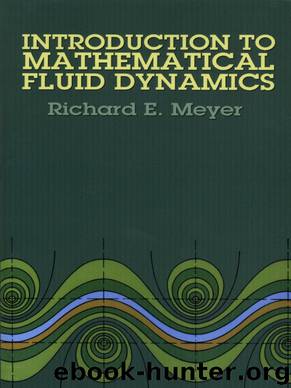Introduction to Mathematical Fluid Dynamics by Richard E. Meyer

Author:Richard E. Meyer
Language: eng
Format: epub
ISBN: 9780486151403
Publisher: INscribe Digital
Published: 2014-01-27T05:00:00+00:00
The fluid and bodies are therefore capable only of a rigid translation; none of the bodies can even be made to rotate! For a proof, see Appendix 19.
The situation is quite different for a viscous fluid. Since p = p(x), but u = u(r), (19.8) implies
dp/dx = const = µA,
say, and u = – Ar2/4 + c1 log r + c2, and (19.7) and (19.6) show the constants of integration to be c1 = 0 and c2 = Aa2/4, so that Poiseuille’s solution,
is obtained, where dr is the total mass flow rate. There is therefore a unique steady flow independent of x and θ and of inlet conditions, which may be approached with increasing distance from the pipe inlet.
It is worth noting that Poiseuille’s flow is an exact solution of the nonlinear partial differential system (4.5), (19.3), sometimes referred to as Navier-Stokes equations (the full system of those equations will be found in Section 38). The number of known exact solutions is not very large, although the term “exact” is conventionally extended to cover not only explicit solutions, like Poiseuille’s and those of Problems 19.1 to 19.3, but also any solution obtainable by (numerical) integration of a system of ordinary differential equations. The exact solutions are therefore particular solutions distinguished by symmetries of one kind or another; surveys of such solutions are found in [21] and [22].
Download
This site does not store any files on its server. We only index and link to content provided by other sites. Please contact the content providers to delete copyright contents if any and email us, we'll remove relevant links or contents immediately.
Modelling of Convective Heat and Mass Transfer in Rotating Flows by Igor V. Shevchuk(6218)
Weapons of Math Destruction by Cathy O'Neil(5818)
Factfulness: Ten Reasons We're Wrong About the World – and Why Things Are Better Than You Think by Hans Rosling(4479)
Descartes' Error by Antonio Damasio(3159)
A Mind For Numbers: How to Excel at Math and Science (Even If You Flunked Algebra) by Barbara Oakley(3100)
Factfulness_Ten Reasons We're Wrong About the World_and Why Things Are Better Than You Think by Hans Rosling(3041)
TCP IP by Todd Lammle(3007)
Applied Predictive Modeling by Max Kuhn & Kjell Johnson(2903)
Fooled by Randomness: The Hidden Role of Chance in Life and in the Markets by Nassim Nicholas Taleb(2852)
The Tyranny of Metrics by Jerry Z. Muller(2842)
The Book of Numbers by Peter Bentley(2778)
The Great Unknown by Marcus du Sautoy(2531)
Once Upon an Algorithm by Martin Erwig(2471)
Easy Algebra Step-by-Step by Sandra Luna McCune(2463)
Lady Luck by Kristen Ashley(2404)
Practical Guide To Principal Component Methods in R (Multivariate Analysis Book 2) by Alboukadel Kassambara(2377)
Police Exams Prep 2018-2019 by Kaplan Test Prep(2351)
All Things Reconsidered by Bill Thompson III(2256)
Linear Time-Invariant Systems, Behaviors and Modules by Ulrich Oberst & Martin Scheicher & Ingrid Scheicher(2229)
